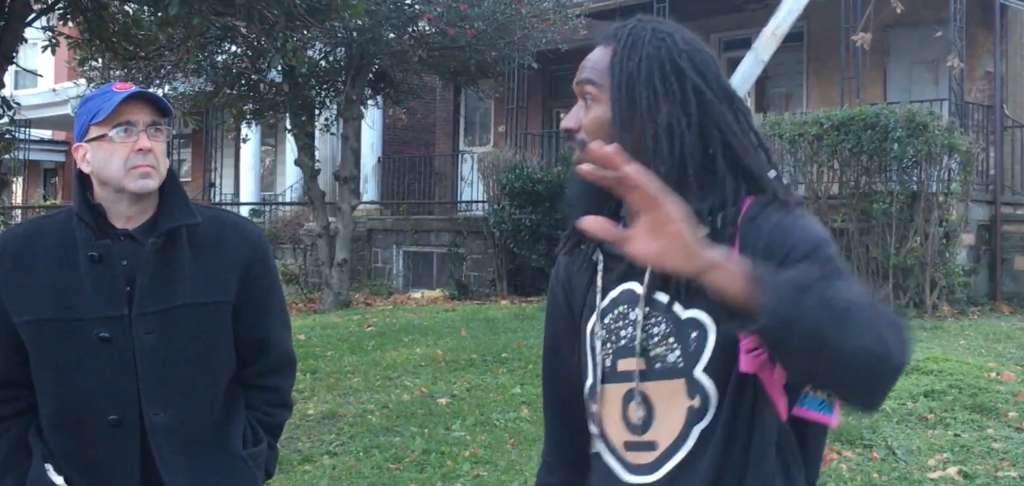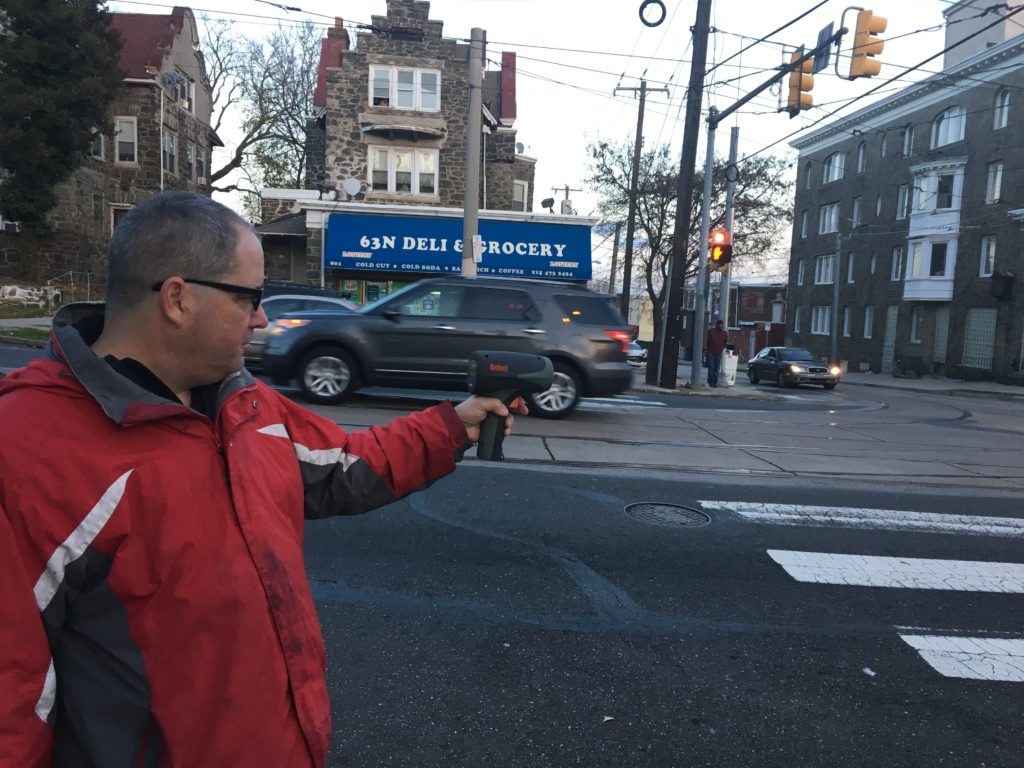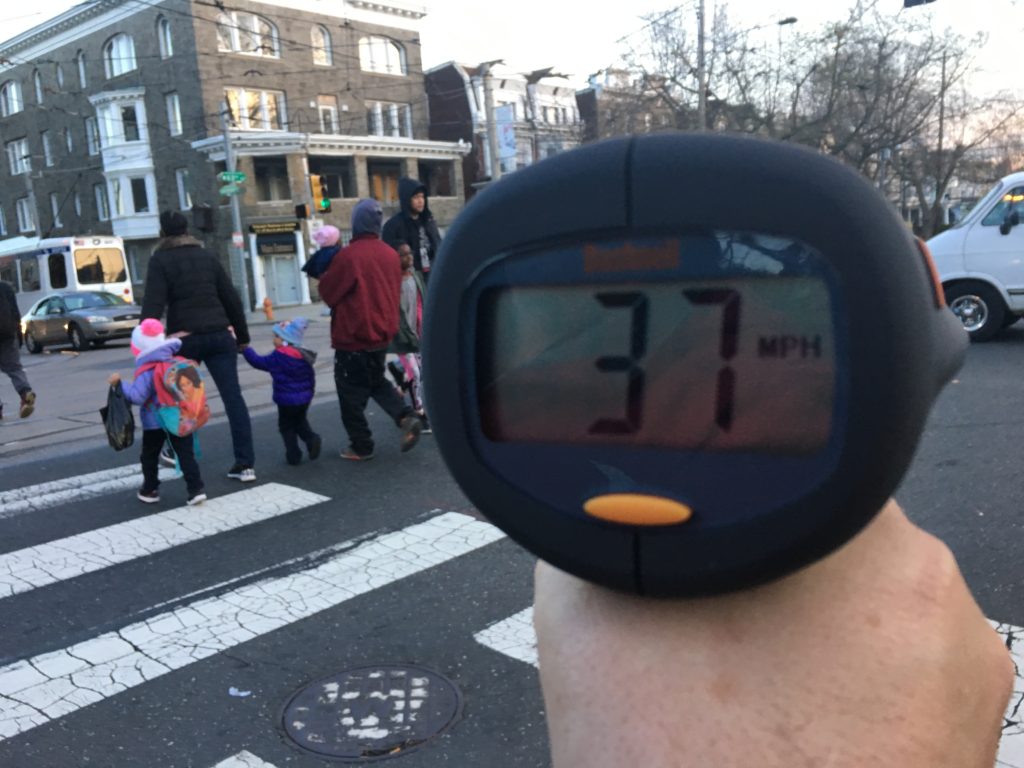
A father explains problems with 63rd and Lansdowne to BCGP policy coordinator
On Monday, members of the Vision Zero Alliance met at 63rd and Lansdowne in West Philadelphia to explore what can be done now to make changes to that intersection for the safety of people crossing there.
On November 18, 8-year-old Jayanna Powell was killed at this intersection while walking home from school with her brother. The incident was a hit-and-run, and after an extensive search, the car involved in the crash was found at a Chester County garage, and the 24-year-old driver was arrested.
In the days since the crash, the Bicycle Coalition has heard from people in the area about the danger of that particular intersection, so we decided to go out to the intersection to see what information we could bring to the city to make the streets safer.
While there, members of the Bicycle Coalition, the Vision Zero Alliance, a local engineer, and volunteers counted the number of cars going through the intersection, timed the speed at which cars traveled through the intersection, and spoke to local residents about the intersection.

BCGP research director John Boyle tracks speed with a radar gun
All had heard of the hit-and-run involving Jayanna Powell, and most agreed the intersection was bad. One man, who witnessed the crash, said he’s been reporting problems with 63rd Street to the city for years.
The corner of 63rd and Lansdowne is a four way intersection, connecting two two-way streets. There are trolley tracks both ways on 63rd, and both ways on Lansdowne, going east.
We witnessed six motor vehicles over the course of 10 minutes run red lights going south on 63rd Street, and numerous vehicles were exceeding the 25 mile per hour speed limit, which was not posted anywhere near the intersection.
One problem we immediately noticed with 63rd Street is basically a race track up to this point. Between Jefferson Street, to the north, and Lansdowne, is basically a two-lane, downhill highway. Cars are able to gain excessive speed on their trip south. We counted many cars exceeding the speed limit via our radar gun.

One neighbor I spoke to, who said he saw the crash, noted he’d been complaining about the intersection and Powell’s death was not the first crash he’d seen at 63rd and Lansdowne—although it was the first fatality.
“When the car hit her, it knocked [her brother] right into the back of this pickup truck parked on the corner … and when the guy hit this little kid, he knew what he did. And when the little boy looked at the guy in the car, he took off,” the neighbor recalled. “It’s a shame, but it’s not the first time this type of [expletive] happened up here.”
The neighbor, who asked he not be named, said he would support putting speed and red light cameras at the intersection, which is an involved process because 63rd is a state road.
We will be continually working with engineers and the city to see what we can get done at this intersection as soon as possible, and will be following up to this blog with additional information once it’s processed.

What is missing here is a proper analysis of the actual cause of this terrible tragedy. As in the case of the tragic death of Jamal Morris, no facts regarding the actual causes of the accident/crash are presented. While leaving the scene suggests some sort of guilt, it does not prove it. Sometimes, the driver leaves the scene out of simple fear. Further, the most comprehensive study of pedestrian deaths when hit by cars shows that deaths most often involve both a contributory action by the pedestrian and a driver with a significant previous history of bad actions. Keeping better track of tickets, warnings, and other indications of truly poor operating technique, as well as warning signs for pedestrians and more public education are the types of solution we should be looking for. In terms of serious pedestrian injuries, the auto is speeding less often than it is speeding. Thus, the single-minded focus on speed repeatedly expressed by Vison Zero advocates is out of place. The stress on speed cameras and red light cameras is also a less than objective way of looking at these problems, and it is embraced by politicians largely because it means “something can be done” without spending any money. The problem here might be as simple as a yellow light that is too short. Agreed, not posting a sensible speed limit near the intersection, and somehow enforcing it in an intelligent manner, may constitute a serious problem. My point is that this is an emotional reaction to a terrible tragedy that needs to be informed by engineering and science, and not just the anger, regret, and disgust that we all share.